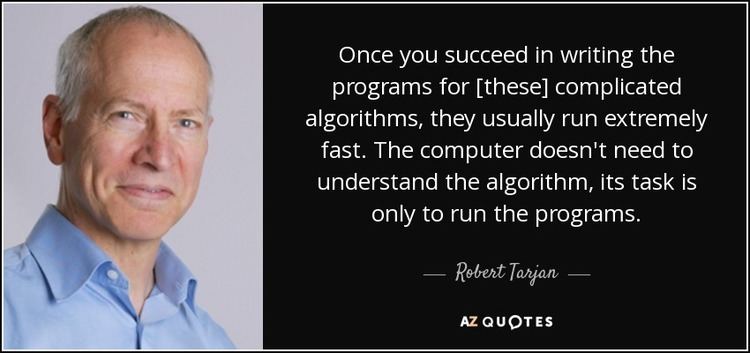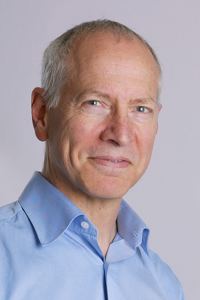Alma mater Caltech,Stanford Name Robert Tarjan | Role Computer scientist Fields Computer Science | |
 | ||
Institutions CornellBerkeleyStanford UniversityNew York UniversityPrinceton UniversityHewlett-PackardMicrosoftIntertrust Thesis An Efficient Planarity Algorithm (1972) Known for Algorithms and data structures Books Data Structures and Network Algorithms, Notes on Introductory Combinatorics Education Similar People John Hopcroft, Martin Gardner, Andrew Dickson White | ||
Diku talk simple algorithms whose analysis isn t by robert tarjan
Robert Endre Tarjan (born April 30, 1948) is an American computer scientist and mathematician. He is the discoverer of several graph algorithms, including Tarjan's off-line lowest common ancestors algorithm, and co-inventor of both splay trees and Fibonacci heaps. Tarjan is currently the James S. McDonnell Distinguished University Professor of Computer Science at Princeton University, and the Chief Scientist at Intertrust Technologies Corporation.
Contents
- Diku talk simple algorithms whose analysis isn t by robert tarjan
- Robert tarjan search tree mysteries
- Early life and education
- Computer science career
- Algorithms and data structures
- Awards
- Patents
- References

Robert tarjan search tree mysteries
Early life and education

He was born in Pomona, California. His father was a child psychiatrist specializing in mental retardation, and ran a state hospital. As a child, Tarjan read a lot of science fiction, and wanted to be an astronomer. He became interested in mathematics after reading Martin Gardner's mathematical games column in Scientific American. He became seriously interested in math in the eighth grade, thanks to a "very stimulating" teacher.

While he was in high school, Tarjan got a job, where he worked IBM punch card collators. He first worked with real computers while studying astronomy at the Summer Science Program in 1964.

Tarjan obtained a Bachelor's degree in mathematics from the California Institute of Technology in 1969. At Stanford University, he received his master's degree in computer science in 1971 and a Ph.D. in computer science (with a minor in mathematics) in 1972. At Stanford, he was supervised by Robert Floyd and Donald Knuth, both highly prominent computer scientists, and his Ph.D. dissertation was An Efficient Planarity Algorithm. Tarjan selected computer science as his area of interest because he believed that computer science was a way of doing mathematics that could have a practical impact.
Computer science career
Tarjan has been teaching at Princeton University since 1985. He has also held academic positions at Cornell University (1972–73), University of California, Berkeley (1973–1975), Stanford University (1974–1980), and New York University (1981–1985). He has also been a fellow of the NEC Research Institute (1989–1997). In April 2013 he joined Microsoft Research Silicon Valley in addition to the position at Princeton. In October 2014 he rejoined Intertrust Technologies as chief scientist.
Tarjan has worked at AT&T Bell Labs (1980–1989), Intertrust Technologies (1997–2001, 2014–present), Compaq (2002) and Hewlett Packard (2006–2013).
Algorithms and data structures
Tarjan is known for his pioneering work on graph theory algorithms and data structures. Some of his well-known algorithms include Tarjan's off-line least common ancestors algorithm, and Tarjan's strongly connected components algorithm, and he was one of five co-authors of the median of medians linear time selection algorithm. The Hopcroft-Tarjan planarity testing algorithm was the first linear-time algorithm for planarity-testing.
Tarjan has also developed important data structures such as the Fibonacci heap (a heap data structure consisting of a forest of trees), and the splay tree (a self-adjusting binary search tree; co-invented by Tarjan and Daniel Sleator). Another significant contribution was the analysis of the disjoint-set data structure; he was the first to prove the optimal runtime involving the inverse Ackermann function.
Awards
Tarjan received the Turing Award jointly with John Hopcroft in 1986. The citation for the award states that it was:
For fundamental achievements in the design and analysis of algorithms and data structures.
Tarjan was also elected an ACM Fellow in 1994. The citation for this award states:
For seminal advances in the design and analysis of data structures and algorithms.
Some of the other awards for Tarjan include:
Patents
Tarjan holds at least 18 U.S. patents. These include:
